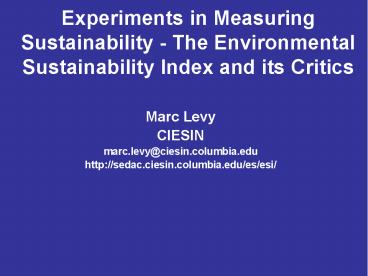Experiments in Measuring Sustainability - The Environmental Sustainability Index and its Critics - PowerPoint PPT Presentation
Title:
Experiments in Measuring Sustainability - The Environmental Sustainability Index and its Critics
Description:
Sustainability Indicators in Context. Understanding. Goal-Setting. Implementation ... Clear Sustainability Targets Remain Elusive ... – PowerPoint PPT presentation
Number of Views:101
Avg rating:3.0/5.0
Title: Experiments in Measuring Sustainability - The Environmental Sustainability Index and its Critics
1
Experiments in Measuring Sustainability - The
Environmental Sustainability Index and its Critics
- Marc Levy
- CIESIN
- marc.levy_at_ciesin.columbia.edu
- http//sedac.ciesin.columbia.edu/es/esi/
2
CIESIN involvement with sustainability indicators
- 1999-2005
- Environmental Sustainability Index
- Collection of national-level indicators suitable
for comparison and aggregation - 2005-2006
- Environmental Performance Index
- Collection of national-level report cards
measuring proximity to policy targets - Proposal to U.S. Millennium Challenge Account
currently in public review (http//www.mca.gov/cou
ntries/selection/NRS_indicator.shtml) - 2002-2006
- Collection of integrated well-being / environment
indicators to support research into systemic
interactions - E.g. Millennium Ecosystem Assessment
3
Sustainability Indicators in Context
Understanding
Evaluation and Learning
Engagement and Deliberation
Goal-Setting
Implementation
Useful Indicators can improve ability to -
Describe problems accurately and saliently -
Diagnose the causes of these problems - Design
solutions commensurate with description and
diagnosis - Drive action with ongoing monitoring
and evaluation
4
Criticism
- Multi-dimensionality plus aggregation confusion
- Aggregates not grounded in theory not subject to
testing - Weights are ultimately arbitrary
5
Response
- There is a demand for aggregated numbers
- Although aggregation can be misused, it can be
useful - Transparency can temper arbitrariness
6
The ESI gives strong weight to social and
institutional capacity measures
- Social and Institutional Capacity one of five
core components of the ESI - 4 of the ESIs 21 indicators are capacity
measures - Governance
- Eco-efficiency
- Private Sector Responsiveness
- Science and Technology
- 24 variables used to quantify these indicators
7
The critique
- Rewards wealthy countries
- Capacity measures arent environmental, so they
cloud the picture of environmental sustainability - Some of attributes of high capacity are linked to
patterns of high environmental stress (e.g.
resource consumption) might send wrong signal
8
Response
- Stick with it because it matters
- Erect clear boundaries separating governance from
drivers and impacts
9
The ESI combines things that are within
governments near-term control and those that are
not
- Exposure to environmental natural hazards
- Endangered species
- Anthropogenic land conversion
- Projected population growth
10
Criticism This confuses whatever signal the ESI
wants to send about performance
- Things that happened long in the past arent
relevant for current planning - Things that cant be controlled arent relevant
11
Response, I
- Given what ESI was trying to quantify, it makes
sense to include both kinds of metrics - ESI is meant to measure ability to maintain
favorable environmental conditions long into the
future - That is a function of the cumulative, interacting
effects of exogenous conditions, behaviors
undertaken in the past, and behaviors undertaken
in the future
12
Response, II
- A Pilot Environmental Performance Index
- Focuses only on measures subject to policy
intervention - Metrics are benchmarked in terms of proximity to
target - Natural Resource Management Indicator
- Proposed for use by Millennium Challenge Account
- Unweighted average of
- Access to water
- Access to sanitation
- Child mortality (age 1-4)
- Achievement of 10 protection target, by biome
13
Clear Sustainability Targets Remain Elusive
- Human-oriented indicators tend to be linked to
clear targets - Child Mortality
- Drinking Water
- Sanitation
- Urban Particulates
- BIG EXCEPTION Indoor Air Pollution
14
- Ecosystem-oriented targets hard to find
- Regional ozone
- Nitrogen loading
- Water consumption
- Wilderness Protection
- Overfishing
These are problems that manifest themselves over
complicated transnational, multi-scale,
coupled-system dynamics
15
Measurement Infrastructure is not Adequate
- Of the 16 indicators included in EPI, only 9 are
updated on a regular basis - The indicators measured regularly are dominated
by human-focused indicators - This reinforces the current policy stalemate
- Hard to set goals when metrics arent available
- Hard to mobilize support for measurement in the
absence of policy goals - MDGs help reinvigorate many socioeconomic
measurement efforts did not have same effect on
the environment































